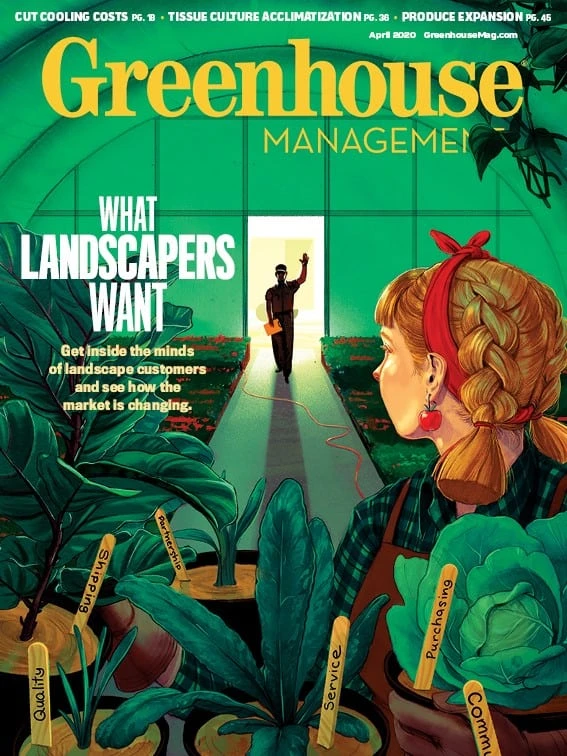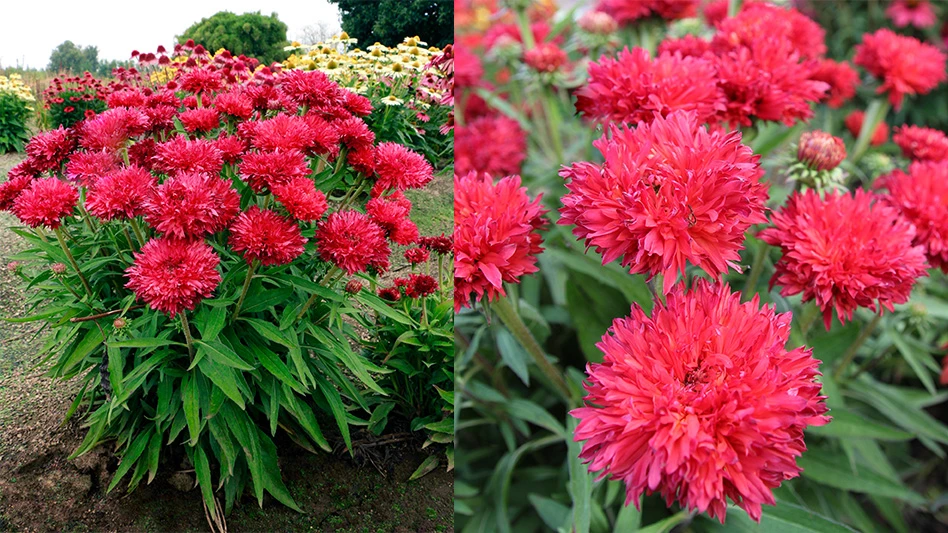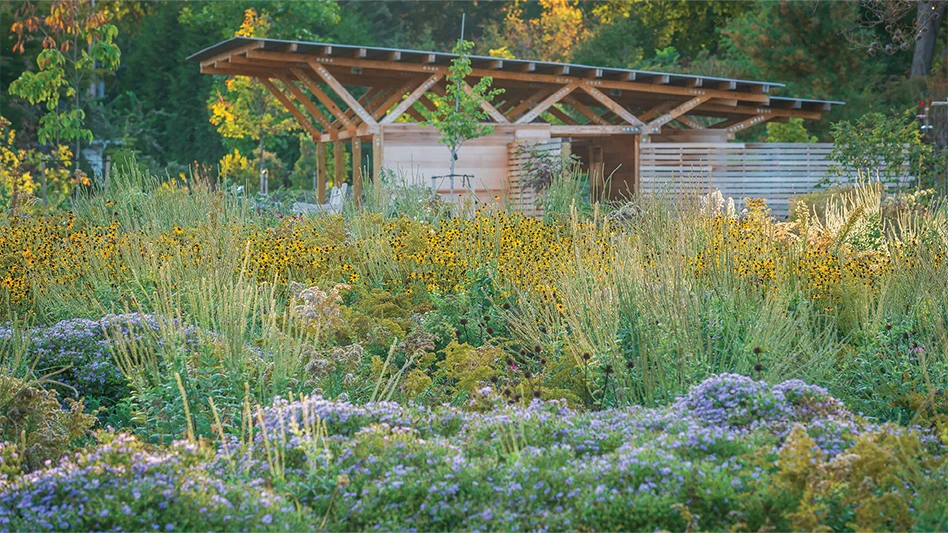 Illustrations by Zoë van Dijk
Illustrations by Zoë van DijkAdding top-notch landscaping firms to your customer list can be a major boost for your greenhouse business. But keeping those accounts satisfied for the long haul is what really counts. How can you know what your landscape customers want and need most? It turns out, all you have to do is ask.
To help expedite the process, Greenhouse Management did the asking for you. We reached out to four premier landscaping companies to find out how they choose their greenhouse partners, what they wish greenhouses understood and how you can add to their success and yours. Here’s what we learned.

Bland Landscaping Company
Raleigh-Durham, North Carolina, area
Known throughout the Carolinas, Bland Landscaping has earned a reputation for masterful use of greenhouse color. “Back in the 1980s, my father recognized that floriculture was a way to differentiate ourselves from others,” says Kurt Bland, president. “Our floriculture is one of the calling cards of our company.”
One Bland employee is devoted solely to the planning and execution of the annual program. That’s how it’s been for more than 30 years. The company generates custom designs for every bed they plant, using unique themes for each property and switching beds out twice a year. Having the plants they want, when they want them requires extensive planning — and coordination with their greenhouse growers.
“Years back, we realized that our growers were not able to get certain plants because they weren’t getting our order prior to spec’ing theirs,” Bland says. “So, we took it upon ourselves to figure out how they function, and then we tailored our approach. We gave them the opportunity to work with us as a partner and understand us better, because we understood what they needed from us.” Now the company floriculturist plans orders six months out.
“Our biggest challenge relative to greenhouse producers is when we go into a new geographic market,” Bland says. “We have to find growers that can think like us, and we've got to teach them what we expect to make it successful. We've had plenty of failures where they did it their way and we just didn't do business anymore.”
Price is not a primary consideration — but consistent quality, logistics and service are. “We don't beat our vendors up on price, but we do have really high service expectations,” Bland says. That includes on-site delivery, orders sorted according to jobsite and precision delivery to coincide with crews. As a result, the company focuses on established, proven greenhouses that know their market and its logistics.
As far as trends, Bland isn’t interested in new color or new plant introductions. “We’re looking for proven combinations that perform like workhorses and give a lot of impact. And we’re looking for it in 4-inch pots and up,” he says. He’s also focused on deer resistance — which is increasingly at the top of the list for greenhouse crops.
Bland advises greenhouse growers to prepare for consolidation in the landscape industry as aging landscapers sell out: The result is higher expectations, tighter margins, greater labor efficiency and logistical demands.
“The industry is going through a massive metamorphosis right now, and it's only going to accelerate in the next decade,” he says. “You're going to see more larger companies. You're going to see more sophisticated companies, and a lot more companies are going to start looking to greenhouse producers to think the way that we ask them to think.”
For greenhouses looking to expand their business for recurring landscape revenue, Bland suggests identifying the best landscapers in your market. Look beyond creativity to reputation and how they pay their bills. Then visit their jobsites and see what plants go through.
“From the time plants leave the greenhouse environment, we won’t see those plants any more than once a week for the rest of their lives,” he says. “If greenhouses don’t get out there and understand that, they’re not going to get the business.”
Metco Landscape
Denver, Colorado, area
Luke Larralde, purchasing manager for Metco Landscape, explains that Denver’s greenhouse market has undergone drastic changes in recent years. As property values soared, many growers chose to sell and move on. As a result, availability is the biggest driver in the company’s choice of greenhouse partners.
“We have this kind of shrinking availability due to people selling out or reducing what they’re selling,” Larralde says. “Especially on the annuals and perennials — a lot of times what we’re doing is chasing the plants.”
For Metco’s commercial and residential customers, media coverage heavily influences annual preferences. Greenhouses that stay on top of trending plants and marketing campaigns gain their business. “Those are the things driving our customer demand,” Larralde says. “They’re not looking through the Ball catalog. They want the one they saw on HGTV.”
In the Denver region, municipal-planting requirements limit commercial plant selection. Approved plant lists — often several years old — determine what designers can use, making catching trends even more difficult. Water conservation and diversity influence choices, but the region’s challenging climate limits plant palettes as well.
While commercial landscapes tend to stick with proven performers, residential trends vacillate between native plants, extremely low water use and “being pretty.” The state’s influx of Californians and Midwesterners used to strong, diverse local greenhouse and nursery cultures complicate that mix even more.
Metco tries to get orders to greenhouse growers in time for custom growing. But that’s the exception more than the rule. Clients often don’t commit until spring weather finally hits. “We tend to have to deal with what's on the market and adjust our plans accordingly and adjust our customer's plans and expectations accordingly as well,” Larralde says.
Greenhouses that have embraced technology and communicate well on what’s planted and what’s ready top the list. That doesn’t mean things like shipping and jobsite delivery and volume incentives don’t matter — they do. “Those things are detailed into our accounts. We have really good pricing structures and good delivery expectations and good communications,” he says. “Our vendors do a really good job on that.”
Larralde suggests greenhouse-driven consumer education would benefit everyone. “We see really good educational outreach for landscapers from the greenhouses. Unfortunately, that information doesn’t always get communicated to the end user,” he says. “I think more consumer education by greenhouses could result in a boom in sales on the products that they’re ultimately trying to sell to us.”
Moore Landscapes
Chicago, Illinois, area
Selecting greenhouse partners rests on several factors at Moore Landscapes in the Chicago area. “We choose our preferred vendors on plants and everything else they do,” says Sean Mallory, Moore’s general manager of interior and city commercial maintenance. “Price is one factor, but equally important is how does it help our production team?”
Showing up organized and on time ranks just as high as the quality and price of the plants themselves. Vendors that deliver client-ready product, fully sorted and on carts that help expedite final deliveries all earn favor. “We have conversations on expectations and logistics, and ask those questions with new vendors upfront,” he says. “That gets factored in when we make our decisions on our preferred vendors.”
“By building relationships, you can help your landscaper customers be better customers for you.” Doug Delano, Level Green Landscaping
Mallory says the firm’s biggest plant challenges are client-driven and vary from case to case. “Being in Chicago, a lot of property managers don't want to sign a contract or even talk about spring or summer until spring’s here and they're not looking at snow anymore,” he says. Of course, greenhouses want their orders months ahead of time.
“I don’t think greenhouses always realize that pressure isn’t something we can react to,” Mallory says. “We are putting pressure on our clients to sign their contracts, but until we have them, we can't just place an order and hope for the best. We custom-cater these designs to the client, so our vendors have to understand that.”
As a result, Mallory says the firm misses pre-books and savings opportunities. When orders come, they’re turned around quickly. That means added pressure on greenhouses to meet their needs. “You know, we do understand it from their point of view,” he says. “I hope they understand it from ours.”
Communication goes a long way in making partnerships work. “We go out of our way to strengthen those relationships and get together with preferred vendors at least once a year to discuss how things can be improved,” Mallory says. “I think a lot of the onus is on the landscapers to make those connections and reach out.”
By sharing things that aren’t working, landscapers give greenhouses an opportunity to understand their needs, make changes and be better partners. “What I appreciate most from a vendor is just taking the time to understand our business, and putting themselves in our shoes,” Mallory says. “You work with me and I'll work with you. Then we can figure it out together. The price and things, that's all second to the people that you're affecting by everything that you do.”

Explore the April 2020 Issue
Check out more from this issue and find your next story to read.
Latest from Greenhouse Management
- Grant awarded to test western U.S. wood species for use as wood fiber potting substrate
- Pennsylvania Horticultural Society announces 2025 Gold Medal Plant winners
- Oasis Grower Solutions announces new Southeast territory sales manager
- A nation of gardeners: A history of the British horticulture industry
- Last Word with Angela Labrum, Bailey Nurseries
- Iowa plant supplier Plantpeddler building retail complex
- This month's Greenhouse Management magazine is about native plants and sustainability
- The HC Companies, Classic Home & Garden merge as Growscape





